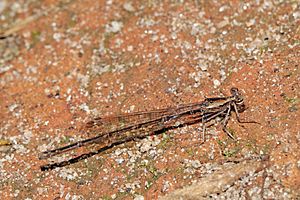Platycnemididae facts for kids
Quick facts for kids Platycnemididae |
|
|---|---|
 |
|
| Copera marginipes | |
| Scientific classification |
|
| Kingdom: | Animalia |
| Phylum: | Arthropoda |
| Class: | Insecta |
| Order: | Odonata |
| Suborder: | Zygoptera |
| Family: | Platycnemididae Jacobson and Bianchi, 1905 |
| Subfamilies | |
|
|
The Platycnemididae are a family of damselflies. They are often called white-legged damselflies because of their unique leg markings. There are more than 400 different kinds, or species, of these damselflies. You can find them mostly in the Old World, which includes places like Africa, Europe, and Asia.
Contents
What are Damselflies?
Damselflies are amazing insects that fly around water. They are related to dragonflies. Both are part of a group called Odonata. Damselflies usually have slimmer bodies than dragonflies. When they rest, most damselflies hold their wings together over their back. Dragonflies, however, often hold their wings out flat.
Where Do White-Legged Damselflies Live?
White-legged damselflies live in many parts of the world. They are found across the "Old World." This means you can see them in Africa, Europe, and Asia. They also live in Australia and the islands of Oceania. These damselflies usually prefer places near fresh water. This includes rivers, streams, and ponds.
What Makes Them Special?
The name "white-legged damselflies" comes from a special feature. Many species in this family have pale or white markings on their legs. These markings can be quite noticeable. They help scientists identify different types of damselflies. These insects are often quite colorful too. They can have bright blue, green, or red bodies.
Life Cycle of a Damselfly
Like many insects, damselflies go through different life stages. This is called a life cycle. It starts with an egg. The female damselfly lays her eggs in or near water. Sometimes she lays them inside plant stems.
From Nymph to Adult
After hatching, the egg becomes a nymph. Nymphs live underwater. They breathe using gills. They are tiny predators, eating small water creatures. Nymphs grow by shedding their skin many times. This process is called molting. When a nymph is ready, it crawls out of the water. It then sheds its skin one last time. This is when it changes into an adult damselfly. The adult damselfly then flies around, mates, and lays eggs. This completes the cycle.
Different Kinds of White-Legged Damselflies
Scientists group living things into categories. A "family" is one of these groups. The Platycnemididae family is divided into smaller groups called "genera" (plural of genus). There are about 50 different genera within this family. Each genus contains one or more species. For example, the Copera genus includes the Copera marginipes species.
Genera include:
- Allocnemis Selys, 1863
- Arabicnemis Waterston, 1984
- Arabineura Schneider & Dumont, 1995
- Archboldargia Lieftinck, 1949
- Arrhenocnemis Lieftinck, 1933
- Asthenocnemis Lieftinck, 1949
- Caconeura Kirby, 1890
- Calicnemia Strand, 1928
- Ciliagrion Sjöstedt, 1917
- Coeliccia Kirby, 1890
- Copera Kirby, 1890
- Cyanocnemis Lieftinck, 1949
- Denticnemis Bartenev, 1956
- Disparoneura Selys, 1860
- Elattoneura Cowley, 1935
- Esme Fraser, 1922
- Hylaeargia Lieftinck, 1949
- Idiocnemis Selys, 1878
- Igneocnemis Hämäläinen, 1991
- Indocnemis Laidlaw, 1917
- Lieftinckia Kimmins, 1957
- Lochmaeocnemis Lieftinck, 1949
- Macrocnemis Theischinger, Gassmann & Richards, 2015
- Matticnemis Dijkstra, 2013
- Melanoneura Fraser, 1922
- Mesocnemis Karsch, 1891
- Metacnemis Hagen, 1863
- Nososticta Hagen, 1860
- Onychargia Selys, 1865
- Oreocnemis Pinhey, 1971
- Palaiargia Förster, 1903
- Papuargia Lieftinck, 1938
- Paracnemis Martin, 1902
- Paramecocnemis Lieftinck, 1932
- Phylloneura Fraser, 1922
- Platycnemididae Strand, 1928
- Platycnemis Burmeister, 1839
- Prodasineura Cowley, 1934
- Proplatycnemis Kennedy, 1920
- Pseudocopera Fraser, 1922
- Rhyacocnemis Lieftinck, 1956
- Risiocnemis Cowley, 1934
- Salomocnemis Lieftinck, 1987
- Spesbona Dijkstra, 2013
- Stenocnemis Karsch, 1899
- Thaumatagrion Lieftinck, 1932
- Torrenticnemis Lieftinck, 1949
- † Cretadisparoneura Huang et al., 2015 Burmese amber, Myanmar, Cenomanian
- † Palaeodisparoneura Poinar, Bechly & Buckley, 2010 Burmese amber, Myanmar, Cenomanian
- † Yijenplatycnemis Zheng et al., 2017 Burmese amber, Myanmar, Cenomanian



